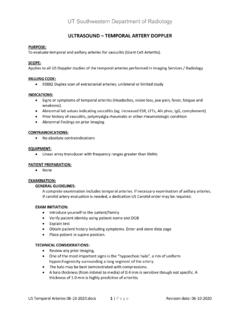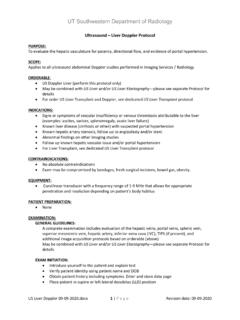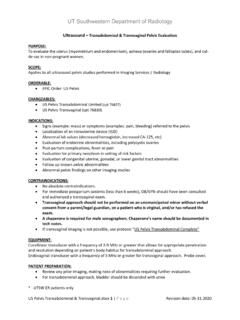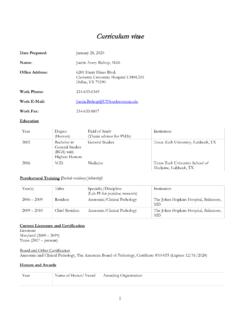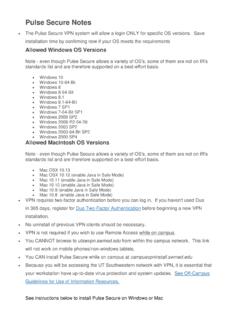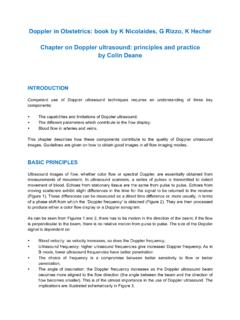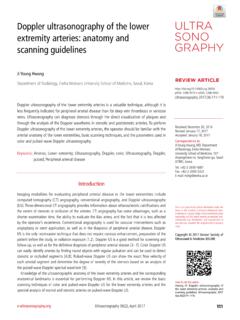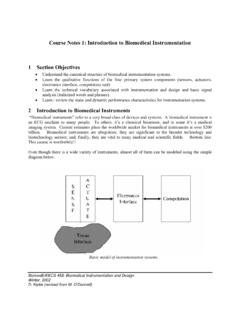Transcription of US Carotid Doppler - UT Southwestern Medical Center
1 UT Southwestern Department of Radiology ULTRASOUND - Carotid Doppler COMPLETE EVALUATION. PURPOSE: To evaluate the extracranial Carotid and vertebral arterial system for atherosclerosis or stenosis SCOPE: Applies to all US Doppler studies of the Carotid arteries performed in Imaging Services / Radiology ORDERABLE: US Doppler Carotid Bilateral / Complete INDICATIONS: Carotid bruit Hemispheric neurological symptoms (eg. stroke, TIA, amaurosis fugax). Non-hemispheric neurological symptoms (eg. vertigo, ataxia, diplopia, drop attacks, sudden blurred vision, bilateral paresthesia).
2 Unexplained neurological symptoms (eg. syncope, headache, memory loss, and confusion). Trauma Pulsatile neck mass History of stenosis Prior endarterectomy Transplant or other major surgery evaluation Carotid stent evaluation CONTRAINDICATIONS: Dizziness alone is not sufficient indication for this exam EQUIPMENT: Select a transducer that allows for appropriate penetration and resolution depending on body habitus. Linear transducer with a frequency range > 9 MHz PATIENT PREPARATION: Introduce yourself to the patient Verify patient identity using patient name and DOB.
3 Explain test Obtain patient history including symptoms. Enter and store data page. Place patient in supine position GENERAL GUIDELINES: A complete examination includes evaluation of the bilateral common, extracranial internal Carotid , and proximal external Carotid arteries as well as the extracranial portions of bilateral vertebral arteries. The examination must be bilateral unless otherwise contraindicated A complete examination includes evaluation of the entire course of the accessible portions of each vessel Variations in technique must be documented ( , stents).
4 US Carotid Doppler . 1| P a g e Revision date: 02-22-2021. TECHNIQUE: Supine position with head tilted away from side of interest Equipment gain and display settings will be optimized while imaging vessels with respect to depth, dynamic range, and focal zones o Color-flow Doppler images with proper color scale to demonstrate areas of high flow and color aliasing o Spectral Doppler gains will be set to allow a spectral window and optimized to reduce artifact o An angle of 60 degrees or less will be used to measure velocities o Doppler angle should always be parallel to the vessel wall Perform evaluation in transverse followed by longitudinal, first right side then left.
5 O Transverse images are taken perpendicular to the long axis of the vessel o Longitudinal images are taken along the long axis of the vessel In transverse plane, label External (E) and Internal (I) Carotid arterials just distal to the bifurcation. Areas of suspected stenosis or obstruction will include spectral Doppler waveforms and velocity measurements recorded at and distal to the stenosis or obstruction Sites of interrogation will include spectral Doppler waveforms and velocity measurements from the proximal, mid, and distal sites Plaque should be assessed and characterized as smooth, irregular, homogenous, or heterogeneous.
6 O Color and angle corrected spectral Doppler imaging may provide additional information including improved visualization of hypoechoic plaque o Transverse grayscale and color images of moderate to severe plaque should be documented o Cine any area of stenosis > 50% in longitudinal and transverse For ICA/CCA Peak Systolic Velocity ratio, use the highest PSV in the internal Carotid artery and the PSV in the distal common Carotid artery. Obtain bilateral brachial blood pressures o Image bilateral subclavian arteries if unable to attain bilateral pressures.
7 Obtain the subclavian PSV to compare right to left. o If there is a > 20 cc/sec difference in the PSV or the BP from left to right, consider subclavian steal. Obtain waveforms of both the medial and lateral aspects of the subclavian artery. Special instructions for duplex of Carotid stent: o Location of the Carotid stent should be determined Most typically stent is placed from CCA-to-ICA. Less commonly, may lie in the ICA only, CCA only, or CCA-to-ECA rarely US Carotid Doppler . 2| P a g e Revision date: 02-22-2021. IMAGE DOCUMENTATION: Carotid ARTERY DUPLEX.
8 Grey Color *Anatomy Waveform PSV EDV. Scale^ Doppler ^. Routine Carotid Duplex CCA transverse: proximal x x CCA transverse: mid x x CCA transverse: distal x x CCA bifurcation: transverse; label I and E x x ICA transverse: bulb x x CCA longitudinal: proximal x x x x x CCA longitudinal: mid x x x x x CCA longitudinal: distal x x x x x ICA longitudinal: bulb x x ICA longitudinal: proximal x x x x x ICA longitudinal: mid x x x x x ICA longitudinal: distal x x x x x ECA longitudinal: proximal Show branching vessels, or x x x x x use temporal tap to confirm ECA.
9 Vertebral artery: longitudinal x x x x x +Subclavian artery: medial x x Included for Carotid Stent Mid/distal CCA before stent (to establish inflow velocity): x x x x x longitudinal Proximal stent (in CCA/bulb): longitudinal x x x x x Mid stent in proximal ICA (usually site of original x x x x x stenosis): longitudinal Distal stent in Distal ICA: longitudinal x x x x x ICA immediately beyond stent: longitudinal x x x x x ECA: longitudinal x x x x x *Perform on right side first, then left side ^Prefer dual/split screen image format +Obtain if unable to take brachial pressure.
10 If subclavian steal is suspected, obtain same images for lateral aspect of the subclavian artery as well. PSV = peak systolic velocity EDV = end diastolic velocity CCA = common Carotid artery ICA = internal Carotid artery ECA = external Carotid artery US Carotid Doppler . 3| P a g e Revision date: 02-22-2021. PROCESSING: Review examination data Export all images to PACS. Confirm data in Imorgon (if applicable). Note any cardiac devices (eg. aortic balloon pump; LVAD; external cardiac pacers; etc). Note any study limitations (in Tech Study Note or paper communication to radiologist, per workflow).
